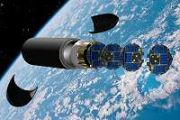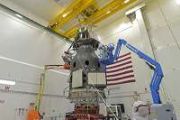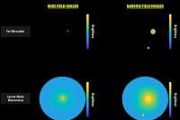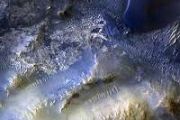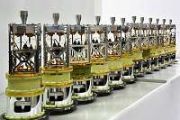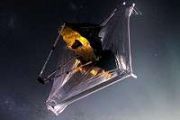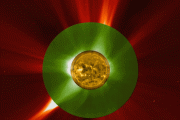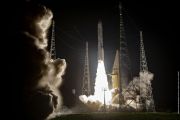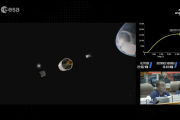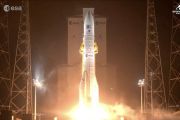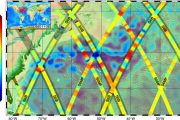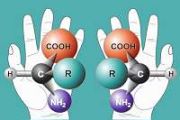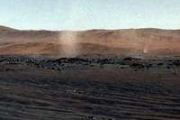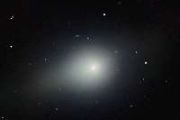
Copernical Team
China launches multiple satellites in back to back launches
 China on Tuesday launched a Long March-6 rocket carrying three satellites into space.
The rocket blasted off at 7:50 am (Beijing Time) from the Taiyuan Satellite Launch Center in the northern province of Shanxi and sent the Shiyan 16A, Shiyan 16B and Shiyan 17 satellites into the preset orbit.
Shiyan means "experiment" in Chinese. The Shiyan satellite trio will provide data for land
China on Tuesday launched a Long March-6 rocket carrying three satellites into space.
The rocket blasted off at 7:50 am (Beijing Time) from the Taiyuan Satellite Launch Center in the northern province of Shanxi and sent the Shiyan 16A, Shiyan 16B and Shiyan 17 satellites into the preset orbit.
Shiyan means "experiment" in Chinese. The Shiyan satellite trio will provide data for land Taikonauts in orbit salute China's manned space program on 30th anniversary
 The Shenzhou-XIV taikonauts, who are aboard the Tiangong space station, gave an off-Earth salute to all participants in China's 30-year manned space program on Wednesday.
In a celebratory video message released by the China Manned Space Agency, taikonauts Chen Dong, Liu Yang and Cai Xuzhe raised their right hands to their heads, expressing their appreciation for the country's accomplishmen
The Shenzhou-XIV taikonauts, who are aboard the Tiangong space station, gave an off-Earth salute to all participants in China's 30-year manned space program on Wednesday.
In a celebratory video message released by the China Manned Space Agency, taikonauts Chen Dong, Liu Yang and Cai Xuzhe raised their right hands to their heads, expressing their appreciation for the country's accomplishmen China's Yunhai 1-03 satellite set to perform various space tasks
 China launched a Long March 2D carrier rocket to send a multitasking satellite into orbit on Wednesday morning, according to China Aerospace Science and Technology Corp.
The State-owned space contractor said in a news release that the rocket blasted off at 7:15 am at the Jiuquan Satellite Launch Center in northwestern China's Gobi Desert and transported the Yunhai 1-03 satellite into its p
China launched a Long March 2D carrier rocket to send a multitasking satellite into orbit on Wednesday morning, according to China Aerospace Science and Technology Corp.
The State-owned space contractor said in a news release that the rocket blasted off at 7:15 am at the Jiuquan Satellite Launch Center in northwestern China's Gobi Desert and transported the Yunhai 1-03 satellite into its p Layering, not liquid: Astronomers explain Mars' watery reflections
 Cornell astronomers believe bright reflections beneath the surface of Mars' South Pole are not necessarily evidence of liquid water, but instead geological layers.
"On Earth, reflections that bright are often an indication of liquid water, even buried lakes like Lake Vostok," said Dan Lalich, research associate. "But on Mars, the prevailing opinion was that it should be too cold for simila
Cornell astronomers believe bright reflections beneath the surface of Mars' South Pole are not necessarily evidence of liquid water, but instead geological layers.
"On Earth, reflections that bright are often an indication of liquid water, even buried lakes like Lake Vostok," said Dan Lalich, research associate. "But on Mars, the prevailing opinion was that it should be too cold for simila Webb's icy instrument reveals complex structures
 These spectacular images feature the spiral galaxy IC 5332, taken by the NASA/ESA Hubble Space Telescope (left) and the NASA/ESA/CSA James Webb Space Telescope (right). The images display the powerful capabilities that both world-leading space telescopes provide, especially when combining their data.
The Webb image shows the spiral galaxy in unprecedented detail thanks to observations from
These spectacular images feature the spiral galaxy IC 5332, taken by the NASA/ESA Hubble Space Telescope (left) and the NASA/ESA/CSA James Webb Space Telescope (right). The images display the powerful capabilities that both world-leading space telescopes provide, especially when combining their data.
The Webb image shows the spiral galaxy in unprecedented detail thanks to observations from DART impacts asteroid target in world first
 After 10 months flying in space, NASA's Double Asteroid Redirection Test (DART), the world's first planetary defense technology demonstration, successfully impacted its asteroid target on Monday - the agency's first attempt to move an asteroid in space. Mission control at the Johns Hopkins Applied Physics Laboratory (APL) in Laurel, Maryland, announced the successful impact at 7:14 p.m. EDT.
After 10 months flying in space, NASA's Double Asteroid Redirection Test (DART), the world's first planetary defense technology demonstration, successfully impacted its asteroid target on Monday - the agency's first attempt to move an asteroid in space. Mission control at the Johns Hopkins Applied Physics Laboratory (APL) in Laurel, Maryland, announced the successful impact at 7:14 p.m. EDT. 'Incredible': Astronomers hail first images of asteroid impact
 The asteroid is flying through space in the grainy black and white video, when suddenly a massive cloud of debris sprays out in front of it, meaning only one thing: impact.
Astronomers have hailed this early footage of the first time humanity deliberately smashed a spacecraft into an asteroid, saying it looks like it did a "lot of damage".
That would be good news, because NASA's Double A
The asteroid is flying through space in the grainy black and white video, when suddenly a massive cloud of debris sprays out in front of it, meaning only one thing: impact.
Astronomers have hailed this early footage of the first time humanity deliberately smashed a spacecraft into an asteroid, saying it looks like it did a "lot of damage".
That would be good news, because NASA's Double A NASA says Artemis launch before November will be 'difficult'
 It will be "difficult" for NASA to make a new attempt to launch its massive Moon rocket in October, an official from the US space agency said Tuesday, with a lift-off in November looking more likely.
The SLS rocket, the most powerful ever designed by NASA, had to be returned overnight to its storage hangar in order to shelter it from the approach of Hurricane Ian.
The next possible lau
It will be "difficult" for NASA to make a new attempt to launch its massive Moon rocket in October, an official from the US space agency said Tuesday, with a lift-off in November looking more likely.
The SLS rocket, the most powerful ever designed by NASA, had to be returned overnight to its storage hangar in order to shelter it from the approach of Hurricane Ian.
The next possible lau NASA moon rocket back in hangar, launch unlikely until November

NASA's moon rocket returned to the safety of its hangar Tuesday as Hurricane Ian approached Florida, its launch now unlikely before mid-November.
Instead of trying to send it on its first test flight, the launch team moved the 322-foot (98-meter) rocket off the pad at Kennedy Space Center.
DART asteroid impact impresses in ESA’s view from the ground
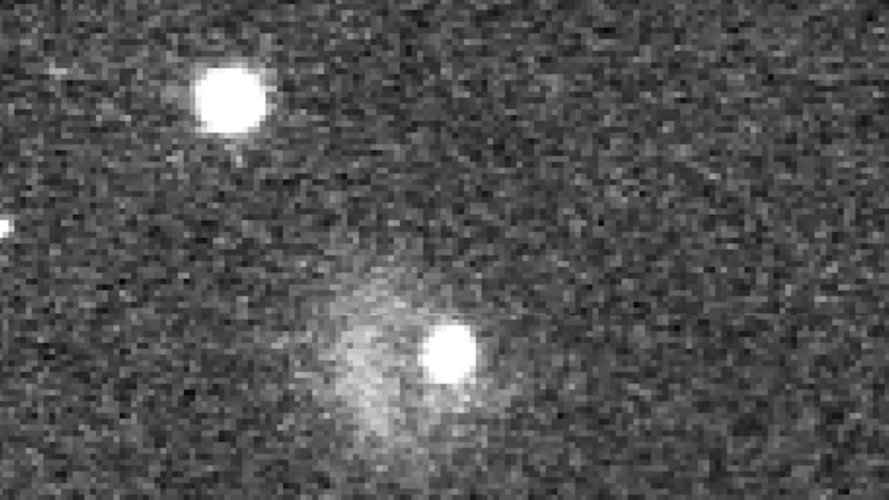 Video:
00:00:12
Video:
00:00:12
Last night at 23:14 UTC, NASA's DART spacecraft successfully struck asteroid Dimorphos, the 160-metre moonlet orbiting around the larger Didymos asteroid. About 38 seconds later, the time it took for the light to arrive at Earth, people all over the world saw the abrupt end of the live stream from the spacecraft, signalling that the impact had happened successfully – DART was no more.
Astronomers on a small slice of our planet’s surface, extending from southern and eastern Africa to the Indian Ocean and the Arabian Peninsula, could actually watch it live with their telescopes. Among those


